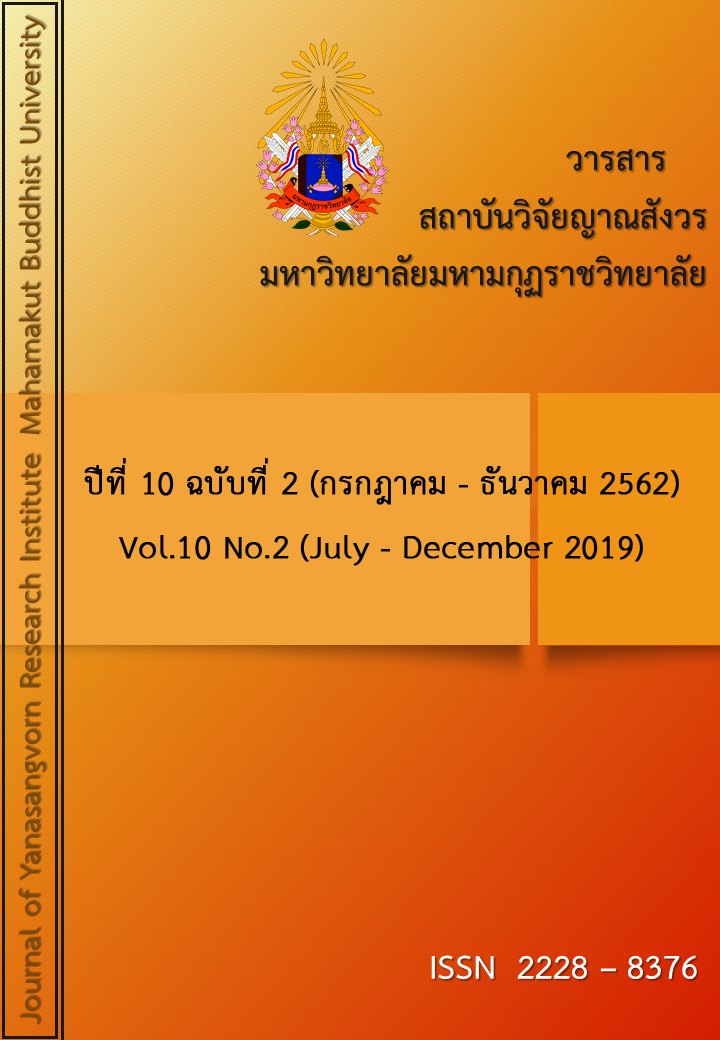AN APPROACH TO THE DEVELOPMENT OF GASTRONOMY TOURISM ROUTE IN BANGKOK NOI, BANGKOK YAI, AND KHLONG SAN DISTRICTS
Main Article Content
Abstract
The objectives of this research were 1) to study tourists' behavior through food culture. 2) To study the marketing mix factors (7Ps) of food culture tourism and 3) to find ways to develop tourism routes through food culture. Mixed method research was quantitative research and qualitative research together, the quantitative research sample was 400 Thai tourists, collected by questionnaires by selecting Multi – Stage Sampling, and data analysis using descriptive statistics, including frequency, percentage, mean, and standard deviation. The statistics used for testing were t-test and one-way ANOVA or F-test of variance analysis, and analysis of differences in mean values by pair of Scheffe´ method with statistical significance at the level of 0.05, the qualitative research would use 17 key informants from government officials, the private sector, the community and academics with expertise in food culture in the community, by collecting data by Structured Interview. The results of the study found that 1) traveling behavior for the most vacation, traveling with friends, traveling time during holidays, Saturday-Sunday, traveling more than 4 times, less travel expenses 300 baht, and the most favorite place was Wanglang alley. Overall, it was found that tourists who came to travel had different sex, marital status, occupation and monthly income, had different behavior in tourism through food culture. 2) Tourists paid more attention to marketing mix factors (7Ps), the overall was at a high level (xˉ = 3.74). Considering each aspect, it was found that every aspect had a high level of average, tourists who came to travel had different sex, marital status, occupation and monthly income would focus on different marketing mix factors (7Ps). 3) Guidelines for the development of tourism routes through food culture should focus on developing elements of tourist attractions (6As), by promoting and developing the area to be a tourist attraction, food culture, with easy access routes, with basic utilities in tourist destinations, creating a tourism network in the community, providing budget support from the public and related private sectors, for employment to people in the community, creating a system for ensuring safety for tourists, and having more food activities, in order to promote and create interest for tourists to visit food culture throughout the year
Article Details
References
กระทรวงการท่องเที่ยวและกีฬา. (2561). ยุทธศาสตร์การท่องเที่ยวไทย ปี พ.ศ.2561-2560. สืบค้นเมื่อ4กุมภาพันธ์2562.https://mgronline.com/business/detail/9610000051969
กอบแก้ว นาจพินิจ. (2542). อาหารไทย. กรุงเทพฯ : โปรแกรมวิชาคหกรรมศาสตร์ทั่วไป คณะวิทยาศาสตร์และเทคโนโลยี สถาบันราชภัฏสวนดุสิต.
ชุติมา อนุตยะสกุล, ประสพชัย พสุนนท์. (2559). ปัจจัยการตัดสินใจของนักท่องเที่ยวชาวไทยต่อการท่องเที่ยวตลาดน้ำวัดล้ำพญา จังหวัดนครปฐม. วิทยานิพนธ์ปริญญาเอกสาขาวิชาการจัดการ คณะวิทยาการจัดการ มหาวิทยาลัยศิลปากร.
ธัญชนก แววแก้ว. (2557). พฤติกรรมการท่องเที่ยวของนักท่องเที่ยวชาวไทยที่เดินทางไปประเทศเกาหลีหรือประเทศญี่ปุ่น. วิทยานิพนธ์ปริญญาบริหารธุรกิจมหาบัณฑิต วิชาเอกการจัดการทั่วไปคณะบริหารธุรกิจ มหาวิทยาลัยเทคโนโลยีราชมงคลธัญบุรี.
ธานินทร์ ศิลป์จารุ. (2555). การวิจัยและวิเคราะห์ข้อมูลทางสถิติด้วย SPSS และ AMOS. พิมพ์ครั้งที่ 13.กรุงเทพฯ : ห้างหุ่นส่วนสามิญบิสซิเนสอาร์แอนด์ดี.
นิตยา งามยิ่งยง และละเอียด ศิลาน้อย. (2560). แนวทางการพัฒนาการท่องเที่ยวอย่างยั่งยืน ชุมชนบริเวณริมฝั่งคลองดำเนินสะดวกในจังหวัดสมุทรสาครและจังหวัดราชบุรี. วารสาร วิทยาลัยดุสิตธานี. 11(1), 149-116.
โรจนศักดิ์ โฉมวิไลลักษณ์ และคณะ. (2558). การท่องเที่ยวเพื่อการเรียนรู้เกี่ยวกับอาหารโดยกลุ่มหาบเร่แผงลอยกับการตัดสินใจเลือกสถานที่ท่องเที่ยว. ทุนสนับสนุนการวิจัยจาก สำนักงานกองทุนสนับสนุนงานวิจัย (สกว.) และสำนักงานคณะกรรมการวิจัยแห่งชาติ.
ศิริวรรณ เสรีรัตน์. (2546). การบริหารการตลาดยุคใหม่ฉบับปรับปรุงปี 2546. กรุงเทพฯ : ธรรมสาร.
สริตา พันธ์เทียน, ทรงคุณ จันทจร, มาริสา โกเศยะโยธิน. (2560). รูปแบบการจัดการท่องเที่ยวเชิงอาหารไทยโดยใช้แนวคิดเศรษฐกิจสร้างสรรค์ในเขตจังหวัดลุ่มแม่น้ำภาคกลาง. งานวิจัยสาขาวิชาวัฒนธรรมศาสตร์ คณะวัฒนธรรมศาสตร์ มหาวิทยาลัยมหาสารคาม.
อมารวดี คำบุญ และดลฤทัย โกวรรธนะกุล. (2556). การประเมินความพร้อมทางการท่องเที่ยวของเมืองท่องเที่ยวขนาดเล็ก อำเภอเขมราฐ จังหวัดอุบลราชธานี. รายงานการศึกษาอิสระปริญญาบริหารธุรกิจมหาบัณฑิต สาขาวิชาการจัดการการท่องเที่ยว คณะวิทยาการจัดการมหาวิทยาลัยขอนแก่น.
อุดม สมบูรณ์ และคณะ. (2558). รูปแบบการจัดกิจกรรมทางวัฒนธรรมเพื่อการการพัฒนาแหล่งท่องเที่ยวในจังหวัดสมุทรสงคราม. ทุนสนับสนุนการวิจัยมหาวิทยาลัยเอเชียอาคเนย์.
Kotler, Philip. (2003). Marketing Management.11th. New jersey : Prentric hall Inc. Pearson Education.


